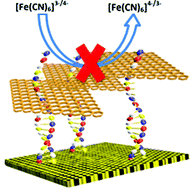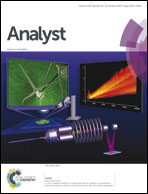Dual amplification of single nucleotide polymorphism detection using graphene oxide and nanoporous gold electrode platform†
Abstract
In the present manuscript, a strategy to prompt the sensitivity of a biosensor based on the dual amplification of signal by applying a nanoporous gold electrode (NPGE) as a support platform and soluble graphene oxide (GO) as an indicator has been developed. By increasing the surface area of the biosensing platform and because of unique GO/ss-DNA interactions, the sensitivity for the detection of SNPs is enhanced. In the presence of SNPs, because of less effective hybridization of mutant targets compared to complementary targets, further GO could adsorb on mutant targets-modified NPGE via π–π interactions, causing a large increase in the charge transfer resistance (Rct) of the electrode. This protocol provides a cost-effective and fast method for the discrimination of different SNPs. Furthermore, this biosensor can detect thermodynamically stable SNP (G–T mismatches) in the range of 15–1600 pM. The present strategy is a label-free and sensitive protocol and does not require sophisticated fabrication.


 Please wait while we load your content...
Please wait while we load your content...